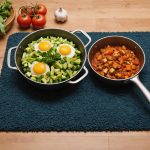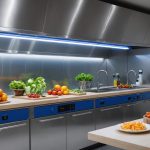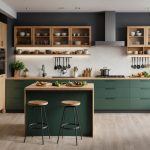Choosing the right wall color for your bright UK kitchen can transform the space into a welcoming haven. A well-chosen hue not only enhances natural light but also complements your kitchen’s design style. From soft pastels to bold shades, the options can feel overwhelming. This guide offers expert tips and inspiring ideas to help you select the perfect color that reflects your personality while ensuring a warm, inviting atmosphere. Embrace the opportunity to revitalize your kitchen with the right paint choice!
Understanding Color Theory for Bright Kitchens
Exploring the vibrant world of kitchen aesthetics through color theory.
Also read : Discover the Top UK Ovens with Exceptional Self-Cleaning Capabilities
Overview of Color Theory Principles
Color theory is a fundamental concept in design, providing a framework for understanding how colors interact. It involves principles such as the color wheel, which organizes colors into primary, secondary, and tertiary categories. This theory helps in creating color harmony, ensuring that different hues work well together. In a kitchen, this harmony can transform the space into a cohesive and inviting environment.
Impact of Color on Mood and Perception
Colors significantly influence our emotions and perceptions. For instance, warm colors like red and yellow can stimulate appetite, making them ideal for kitchens. Conversely, cool colors such as blue and green tend to create a calming effect. Understanding color psychology allows homeowners to choose shades that evoke the desired mood, enhancing the kitchen's overall ambiance.
In parallel : Discover the Top UK Ovens with Exceptional Self-Cleaning Capabilities
Importance of Color Harmony in Kitchen Design
Achieving color harmony is crucial in kitchen design. It involves balancing colors to create a visually pleasing and functional space. Consider these combinations for a bright kitchen:
- Monochromatic: Different shades of a single color
- Analogous: Colors next to each other on the color wheel
- Complementary: Colors opposite each other on the wheel
By applying color theory, one can design a kitchen that is not only aesthetically pleasing but also psychologically uplifting.
Current Color Trends in UK Kitchens
Exploring the latest in kitchen aesthetics through color choices.
Analysis of Trending Color Palettes
In the UK, kitchen color trends are continually evolving, reflecting broader design shifts. Currently, popular palettes embrace both bold and subtle hues. Earthy tones like terracotta and sage green are gaining traction, offering warmth and connection to nature. Meanwhile, neutral palettes remain steadfast favorites, providing versatility and timeless appeal.
Seasonal Influences on Color Choices
Seasonal changes significantly influence kitchen color trends. In spring, lighter shades such as pastel pinks and blues often emerge, reflecting the rejuvenation of the season. Conversely, autumn inspires deeper, richer colors like burnt orange and mustard yellow, aligning with the natural landscape. These shifts allow homeowners to refresh their spaces in harmony with the seasons.
Predictions for Future Color Trends
Looking ahead, kitchen color trends in the UK are expected to continue embracing sustainability and nature-inspired hues. Expect to see a rise in biophilic designs, incorporating greens and browns that mimic outdoor environments. Additionally, the integration of technology in design may lead to more dynamic palettes, offering customizable color schemes.
- Current Trends: Earthy tones, neutrals
- Seasonal Influences: Pastels in spring, rich tones in autumn
- Future Predictions: Biophilic designs, dynamic palettes
By staying informed on these trends, homeowners can ensure their kitchens remain stylish and inviting.
Assessing Natural Light in Your Kitchen
Understanding the role of natural light in kitchen design.
How Natural Light Affects Color Appearance
Natural light plays a crucial role in how colors are perceived in your kitchen. The amount and quality of natural light can dramatically alter the appearance of color palettes, making them appear warmer or cooler. For instance, a kitchen bathed in morning sunlight might make colors appear more vibrant, while the same hues may seem muted under the softer light of the evening.
Techniques for Evaluating Light Throughout the Day
To accurately assess how natural light affects your kitchen, observe the space at different times. Pay attention to changes in color perception as the day progresses. Here are some tips:
- Morning: Evaluate how early sunlight influences color warmth.
- Afternoon: Note the intensity and direction of light.
- Evening: Observe how fading light alters color tones.
Tools for Measuring Natural Light in Your Space
Utilizing tools can provide precise measurements of natural light. A light meter is an excellent device for gauging light intensity. Additionally, a colorimeter can help determine how light affects color perception. These tools offer a scientific approach to ensuring your kitchen's colors are consistent and harmonious throughout the day.
Choosing Colors for Different Kitchen Styles
Exploring color selection to achieve design cohesion across various kitchen styles.
Modern Kitchens
In modern kitchens, clean lines and minimalism are key. Opt for neutral palettes such as whites, grays, and blacks to maintain a sleek aesthetic. These colors can be accented with bold hues like navy or emerald for a contemporary touch. Balancing color with cabinetry and countertops is crucial; consider high-gloss finishes to reflect light and enhance space.
Traditional Kitchens
Traditional kitchens benefit from rich, warm colors that evoke a sense of timelessness. Deep reds, forest greens, and buttery yellows can complement classic wood cabinetry and stone countertops. These colors add depth and sophistication, creating a welcoming atmosphere. A harmonious blend of colors ensures design cohesion, enhancing the space's elegance.
Rustic Kitchens
For rustic kitchens, earthy tones such as terracotta, olive green, and warm browns are ideal. These colors harmonize with natural materials like wood and stone, reinforcing the kitchen's cozy, inviting feel. Consider distressed finishes to enhance the rustic charm.
- Modern: Neutrals with bold accents
- Traditional: Rich and warm hues
- Rustic: Earthy tones with natural materials
Each kitchen style benefits from thoughtful color selection, ensuring a cohesive and visually appealing design.
Testing Paint Colors in Your Kitchen
Exploring effective methods for choosing the perfect shade.
Methods for Testing Paint Colors Effectively
Paint testing is essential for selecting the right color for your kitchen. Start by applying color samples directly onto your walls. This method allows you to see how a shade interacts with existing elements like cabinetry and countertops. Use large swatches to cover ample wall space, providing a better visual representation.
Importance of Testing in Different Lighting Conditions
Lighting greatly influences paint testing outcomes. Test color samples at various times of the day to observe changes under different lighting conditions. Morning light may enhance warm tones, while afternoon light can wash them out. Evening light tends to soften colors, offering a more subdued appearance.
- Morning: Check vibrancy and warmth
- Afternoon: Assess intensity and direction
- Evening: Note softening effects
Tips for Using Paint Samples to Visualize Final Results
To maximize the effectiveness of paint testing, apply color samples on multiple walls. This helps visualize how light affects the hue from different angles. Consider using paint samples with varying finishes, such as matte or gloss, to see how they impact the overall look. These steps ensure a well-informed decision, leading to a cohesive kitchen design.
Complementary Colors for Bright Spaces
Enhancing kitchen vibrancy through strategic color combinations.
The Role of Complementary Colors
Complementary colors are pairs of hues directly opposite each other on the color wheel, known for their ability to enhance brightness and vibrancy. In a kitchen, using these colors can create dynamic visual interest and elevate the space's energy. By balancing bold colors, you can achieve a harmonious yet lively atmosphere.
Popular Complementary Color Pairings for Kitchens
Incorporating complementary color combinations can significantly transform your kitchen. Consider these popular pairings:
- Blue and Orange: Offers a refreshing contrast, perfect for modern kitchens.
- Red and Green: Adds warmth and richness, ideal for traditional settings.
- Yellow and Purple: Provides a vibrant and playful touch, suitable for eclectic designs.
These pairings not only enhance brightness but also add depth and character to the space.
Visual Examples of Effective Color Combinations
To visualize the impact of complementary colors in kitchens, here are some examples:
- Blue Cabinets with Orange Accents: Creates a bold, contemporary look.
- Red Walls with Green Backsplash: Infuses warmth and elegance.
- Yellow Island with Purple Stools: Introduces a fun, inviting atmosphere.
By carefully selecting complementary colors, you can achieve a bright and vibrant kitchen that reflects your style.
Practical Application of Color in Kitchen Design
Exploring effective strategies for color application in kitchen layouts.
Strategies for Applying Color
Incorporating color application into a kitchen design requires thoughtful strategies. Start by painting walls in a dominant color that complements the kitchen's style. Use lighter shades on ceilings to create an illusion of space. Accents, such as backsplashes or cabinet handles, can add pops of color, enhancing the kitchen's vibrancy.
Importance of Balance and Proportion
Achieving the right balance and proportion in color application is crucial. Too much of one hue can overwhelm the space, while too little may not achieve the desired effect. A well-balanced kitchen design considers the distribution of colors across different elements. For a cohesive look, maintain a 60-30-10 ratio: 60% dominant color, 30% secondary color, and 10% accent color.
Case Studies Showcasing Practical Color Applications
Consider these examples:
- Case Study 1: A modern kitchen uses white as the dominant color, with navy cabinets and gold accents, achieving balance.
- Case Study 2: A rustic kitchen features terracotta walls, olive green cabinets, and wooden accents, creating warmth and depth.
By applying these design tips, you can transform your kitchen layout into a harmonious and aesthetically pleasing environment.
Creating a Cohesive Color Palette
Developing a unified and harmonious color scheme for your kitchen.
Steps to Create a Unified Color Scheme
Creating a cohesive palette involves thoughtful color coordination to achieve design unity. Start by selecting a dominant color that reflects your kitchen's style. Complement this with secondary and accent colors, maintaining a balanced distribution. Consider the 60-30-10 rule: 60% dominant, 30% secondary, and 10% accent.
Influence of Adjacent Rooms on Color Selection
The colors of adjacent rooms can significantly affect your color coordination. Ensuring design unity across spaces creates a seamless flow. If your living room features cool tones, extend these hues into the kitchen for a cohesive palette. This approach fosters a unified aesthetic, enhancing the overall home environment.
Tools and Resources for Color Palette Creation
Utilize tools to aid in developing a cohesive palette. Color wheel apps and design software offer visual aids for color coordination. These resources allow experimentation with various combinations, ensuring design unity. Consulting with a color expert can also provide valuable insights.
- Tools: Color wheel apps, design software
- Resources: Online color palette generators, expert consultations
By following these guidelines, you can create a kitchen that not only stands out but also harmonizes with the rest of your home.
Expert Insights on Color Selection
Exploring professional perspectives on kitchen color choices.
Interviews with Interior Designers
Interior designers emphasize the importance of understanding a kitchen's natural light and existing elements before selecting colors. One designer noted, "The key is to create a color scheme that enhances both the space and the homeowner's personal style." Designers often recommend starting with a neutral base and adding bold accents for depth.
Common Pitfalls in Color Selection
Avoiding common mistakes is crucial when choosing kitchen colors. Designers warn against neglecting the influence of adjacent rooms, which can disrupt the home's overall aesthetic. Another pitfall is the overuse of trendy colors, which may quickly become dated. Instead, experts suggest incorporating timeless hues that offer design flexibility.
Resources for Professional Color Consultations
For those seeking personalized advice, professional color consultations can be invaluable. These services provide tailored recommendations, ensuring a harmonious and stylish kitchen design. Consider these resources:
- Consultation Services: Personalized guidance from experts
- Design Software: Tools for visualizing potential color schemes
- Color Workshops: Learning sessions with industry professionals
By leveraging expert insights and resources, homeowners can confidently navigate the complexities of kitchen color selection, achieving a space that is both beautiful and functional.
Visual Inspiration and Case Studies
Exploring stunning transformations to inspire your kitchen design.
Compilation of Stunning UK Kitchen Transformations
Discovering kitchen design inspiration often begins with examining real-world examples. In the UK, numerous kitchens have undergone transformations that highlight the power of strategic color choices. These spaces showcase how different hues can redefine a kitchen's atmosphere, from cozy rustic retreats to sleek modern sanctuaries.
Analysis of Color Choices in Featured Case Studies
Each transformation tells a unique story of color choices impacting design. For instance, a London kitchen utilized a neutral palette with subtle pops of teal, creating a serene yet vibrant environment. Another case study from Manchester featured bold complementary colors, such as navy and mustard, adding depth and character to a compact space.
Visual Guides to Inspire Your Own Kitchen Color Decisions
To assist in visualizing your own kitchen design inspiration, consider these elements:
- Color Wheel: Use to explore harmonious combinations.
- Mood Boards: Compile images that capture your desired aesthetic.
- Sample Swatches: Test multiple hues in your space.
These tools can guide your color choices, ensuring a cohesive and personalized kitchen design. By examining these case studies, you can draw inspiration to create a kitchen that reflects your style and enhances your home's ambiance.













